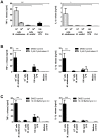The intestinal archaea Methanosphaera stadtmanae and Methanobrevibacter smithii activate human dendritic cells
- PMID: 24915454
- PMCID: PMC4051749
- DOI: 10.1371/journal.pone.0099411
The intestinal archaea Methanosphaera stadtmanae and Methanobrevibacter smithii activate human dendritic cells
Abstract
The methanoarchaea Methanosphaera stadtmanae and Methanobrevibacter smithii are known to be part of the indigenous human gut microbiota. Although the immunomodulatory effects of bacterial gut commensals have been studied extensively in the last decade, the impact of methanoarchaea in human's health and disease was rarely examined. Consequently, we studied and report here on the effects of M. stadtmanae and M. smithii on human immune cells. Whereas exposure to M. stadtmanae leads to substantial release of proinflammatory cytokines in monocyte-derived dendritic cells (moDCs), only weak activation was detected after incubation with M. smithii. Phagocytosis of M. stadtmanae by moDCs was demonstrated by confocal microscopy as well as transmission electronic microscopy (TEM) and shown to be crucial for cellular activation by using specific inhibitors. Both strains, albeit to different extents, initiate a maturation program in moDCs as revealed by up-regulation of the cell-surface receptors CD86 and CD197 suggesting additional activation of adaptive immune responses. Furthermore, M. stadtmanae and M. smithii were capable to alter the gene expression of antimicrobial peptides in moDCs to different extents. Taken together, our findings strongly argue that the archaeal gut inhabitants M. stadtmanae and M. smithii are specifically recognized by the human innate immune system. Moreover, both strains are capable of inducing an inflammatory cytokine response to different extents arguing that they might have diverse immunomodulatory functions. In conclusion, we propose that the impact of intestinal methanoarchaea on pathological conditions involving the gut microbiota has been underestimated until now.
Conflict of interest statement
Figures




References
-
- DeLong EF, Pace NR (2001) Environmental diversity of bacteria and archaea. Systematic Biology 50: 470–478. - PubMed
-
- Chaban B, Ng SY, Jarrell KF (2006) Archaeal habitats–from the extreme to the ordinary. Canadian Journal of Microbiology 52: 73–116. - PubMed
-
- Conway de Macario E, Macario AJL (2009) Methanogenic archaea in health and disease: a novel paradigm of microbial pathogenesis. International Journal of Medical Microbiology 299: 99–108. - PubMed
Publication types
MeSH terms
Substances
LinkOut - more resources
Full Text Sources
Other Literature Sources
Molecular Biology Databases

